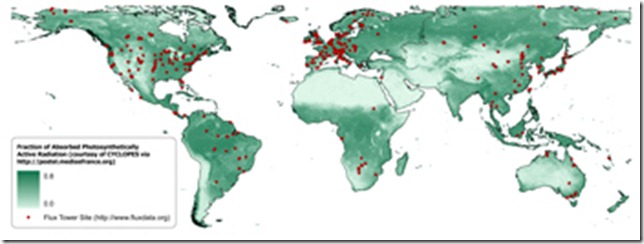Relationship between Climate and the “breathing of the biosphere”
Two international studies from the FLUXNET collaboration were published this week in Science. The papers “Terrestrial Gross Carbon Dioxide Uptake: Global Distribution and Covariation with Climate” and “Global Convergence in the Temperature Sensitivity of Respiration at Ecosystem Level” give us new understanding in the relationship between climate and the “breathing of the biosphere”.
The analyses suggest that from a global point of view, the availability of water may be more important than temperature for carbon fixation by plants. This result poses new questions about existing predictions of ecosystem changes, such as tropical forest decline, in response to temperature change.
In most ecosystems, the rate of photosynthesis – plants breathing in – was observed to change relatively little with temperature. Similarly, the rate of respiration – plants breathing out – also increases relatively less with temperature than previously assumed. Researchers found that the rate at which plants and microorganisms convert sugar into carbon dioxide does not even double when the temperature increases by ten degrees from one week to the next.
This smaller temperature dependence is the same all over the world – from tropical savannahs to forests in Finland. That is also in contradiction to previous work that suggested that temperature sensitivity was less in the tropics and temperate latitudes.
Over 40 percent of the earth’s vegetative surface reacts very sensitively to changes in the amount of precipitation. This emphasizes the importance of water for continued food production. Other factors such as the slow transformations of carbon in the soil also appear to play crucial roles in long term carbon balances.
The researchers analyzed sensor and field observations from 60 different FLUXNET sites as well as remote sensing, climate modeling, and other climate data. Like the biosphere, the FLUXNET dataset is a living breathing dataset. Scientists access and collectively maintain that dataset through a collaborative portal built by computer scientists at Microsoft Research, Lawrence Berkeley Laboratory, and the University of Virginia. The ability to share data at this scale and diversity enables new insights and can reduce the uncertainty of existing model predictions.
Fig. 1: Countless measurement stations (red) around the globe record the exchange of carbon dioxide and water in different ecosystems.
Image: Ulrich Weber, MPI for Biogeochemistry
